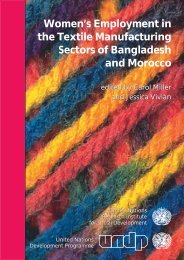The Politics of Gender and Reconstruction in Afghanistan
The Politics of Gender and Reconstruction in Afghanistan
The Politics of Gender and Reconstruction in Afghanistan
You also want an ePaper? Increase the reach of your titles
YUMPU automatically turns print PDFs into web optimized ePapers that Google loves.
STATE-BUILDING IN AFGHANISTAN: A TROUBLED TRAJECTORY<br />
the strictest control <strong>of</strong> women (Rub<strong>in</strong> 1997). <strong>The</strong> damage <strong>in</strong>flicted by Taliban decrees was extensive; whereas<br />
previously 70 per cent <strong>of</strong> teachers, almost half <strong>of</strong> civil servants <strong>and</strong> 40 per cent <strong>of</strong> doctors had been women,<br />
they were altogether banned from paid employment, <strong>in</strong>clud<strong>in</strong>g trade, <strong>and</strong> prohibited from leav<strong>in</strong>g their homes<br />
without a mahram (an immediate male relative). For war widows who had become the sole breadw<strong>in</strong>ners <strong>of</strong> their<br />
families, this meant levels <strong>of</strong> destitution that reduced many to begg<strong>in</strong>g or prostitution. By the time the Taliban<br />
were ousted <strong>in</strong> the aftermath <strong>of</strong> the 11 September 2001 attacks on the United States, the plight <strong>of</strong> Afghan<br />
women under their rule had become widely publicized as one <strong>of</strong> the humanitarian issues justify<strong>in</strong>g <strong>in</strong>tervention.<br />
<strong>The</strong> Bonn Agreement <strong>of</strong> 2001 <strong>in</strong>cluded a clearly stated commitment to ma<strong>in</strong>stream<strong>in</strong>g gender issues <strong>and</strong><br />
redress<strong>in</strong>g past <strong>in</strong>justices. However, the limitations <strong>of</strong> these undertak<strong>in</strong>gs must be clear <strong>in</strong> a context where<br />
security cont<strong>in</strong>ues to be extremely precarious, where viable governance structures are far from established, <strong>and</strong><br />
where the contacts <strong>of</strong> the majority <strong>of</strong> women <strong>in</strong> <strong>Afghanistan</strong> with state apparatuses, markets <strong>and</strong> civil society<br />
organizations are limited to the po<strong>in</strong>t <strong>of</strong> be<strong>in</strong>g non-existent. <strong>The</strong> life options <strong>of</strong> women are conditioned by the<br />
fortunes <strong>of</strong> the communities <strong>and</strong> households <strong>in</strong> which their livelihoods <strong>and</strong> everyday lives are embedded.<br />
Although the dislocations experienced over two decades <strong>of</strong> civil war, compounded more recently by a severe<br />
drought, have received detailed attention <strong>in</strong> studies <strong>of</strong> the political economy <strong>of</strong> conflict <strong>and</strong> livelihoods <strong>in</strong><br />
<strong>Afghanistan</strong>, 12 the gender effects <strong>of</strong> these upheavals are poorly understood. <strong>The</strong> demographic l<strong>and</strong>scape <strong>of</strong> wartorn<br />
societies displays decl<strong>in</strong><strong>in</strong>g male populations, chang<strong>in</strong>g structures <strong>and</strong> compositions <strong>of</strong> households, sharp<br />
<strong>in</strong>creases <strong>in</strong> the number <strong>of</strong> widows <strong>and</strong> female-headed households, <strong>and</strong> a majority <strong>of</strong> women <strong>and</strong> children among<br />
the displaced <strong>in</strong> refugee camps. In <strong>Afghanistan</strong>, where there is a strong norm <strong>of</strong> male responsibility for the protection<br />
<strong>of</strong> women <strong>in</strong> the domestic doma<strong>in</strong>, these dislocations may be experienced not merely as economic disasters<br />
<strong>and</strong> humanitarian tragedies but as normative <strong>and</strong> moral crises that dem<strong>and</strong> regulation, sometimes through violent<br />
<strong>and</strong> ideological means. <strong>The</strong> contradictory effects <strong>of</strong> war <strong>and</strong> displacement on age <strong>and</strong> gender hierarchies<br />
<strong>in</strong> households <strong>and</strong> communities, both unsettl<strong>in</strong>g <strong>and</strong> re<strong>in</strong>forc<strong>in</strong>g aspects <strong>of</strong> patriarchal control, have yet to be<br />
<strong>in</strong>vestigated.<br />
12 Rub<strong>in</strong> 2000; Pa<strong>in</strong> <strong>and</strong> Goodh<strong>and</strong> 2002; Pa<strong>in</strong> <strong>and</strong> Lautze 2002; Bhatia et al. 2003; Cramer <strong>and</strong> Goodh<strong>and</strong> 2002.<br />
PAGE 7
















